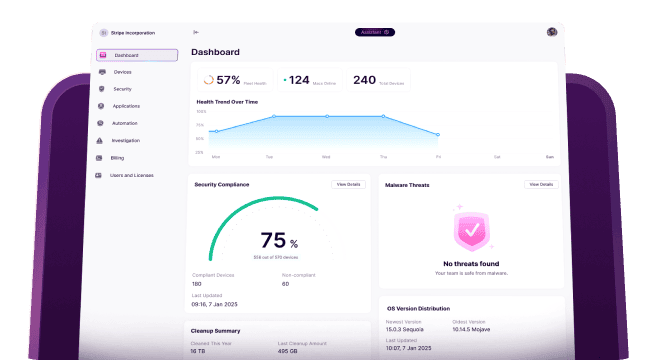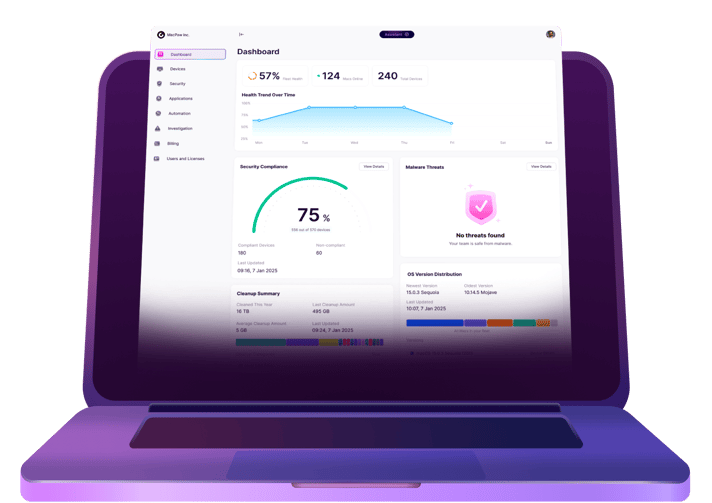Technology continues to change how we work and how we live. It allows us to stay connected digitally, so we can be even more remote physically. That’s what makes real-time communication even more important for business in today’s fast-paced world.
For IT teams, communication with the users you support is becoming increasingly more difficult. You’re not always able to walk over to someone’s desk on their lunch break and run software updates. This is where Apple’s Push Notification (APN) can help.
In this article, I’ll explore what APN is and the benefits it offers to Mac admins. You’ll also read about how to test the service and effectively use it to your advantage. Understanding APNs service will help you harness its full potential in your organization. Let’s get into it!

What is Apple Push Notification service (APNs)?
Even if you’re not familiar with APNs service, you haven’t used a Mac, iPhone, or iPad without coming across a push notification. On these devices, it’s typically various apps that pop up to alert you to something. You know the ones. Push notifications are what pop up when you get a new text or email. Or when an app wants you to know there’s a “super sale” happening this weekend.
But did you know Apple’s Push Notification service is something you and your IT team can use to communicate with your users? APNs are a highly scalable and efficient method to deliver real-time alerts and updates. They help keep your users in the loop on important events and information.
Just like the notifications you’re used to from the apps on your iPhone or Mac, you can use badges, sounds, or custom text to alert your users on their devices. APNs is the backbone behind these features. It handles the delivery and displaying of these messages to ensure they reach the intended recipients quickly and reliably.
Benefits of APNs for Mac Admins
It’s easy to think of push notifications as simply glorified emails or messages. But that’s only half of what they provide. It’s important to take a step back and look at them in the full context of your user’s experience. Take a look at just a few of the benefits APNs offer your team:
1. Real-time communication
This is probably the most obvious benefit that APNs provide, but it’s not something that should be taken for granted. APNs give the power to instantly communicate between your servers and your users’ devices. Now you know your users are getting critical updates and information immediately — it’s not getting lost in their inbox.
2. Improved user engagement
Rather than sending out a lengthy email that includes multiple steps for the user to perform, a push notification is interactive. It allows the user to engage with exactly what you’re asking or needing them to do. This streamlined experience typically provides better results and guarantees a better user experience.
3. Simplified device management
Because push notifications can be interactive and engaging, it makes it easier for IT teams to effectively manage and monitor Apple devices. This also includes remotely installing software and security patches.
4. Enhanced security
Push notifications, all around, are a more secure method of communication. All the messages are encrypted, even while they’re being sent. This is helpful for sending sensitive data because you know it will stay protected and confidential.
Testing APNs
Anytime you introduce a new component into your environment, it’s absolutely critical to test it over and over to ensure smooth performance when you roll it out. Here are a few tips to help you test out your APN before you start using it:
- Get a valid APNs certificate: The first thing you’ll need to test is your Apple APNs certificate. This is how your servers are able to talk to the APN.
- Create a notification: Next is to craft your notification. Since this is only a test, you can make a simple payload using JSON to use for now.
- Use a push notification testing tool: Now, you should use a notification testing tool to send your payload to test devices. There are quite a few APN tools available. Using these tools can help you quickly identify any issues in your workflow.
- Monitor delivery and performance: Finally, you’ll want to monitor and track the delivery of your notification. Keeping an eye on things like speed and sufficient delivery metrics will tell you if everything is functioning properly.
Using APNs in Your Organization
After you’ve rigorously tested your APN and are confident in its performance, now it’s time to start implementing it into your environment. Here are a couple of best practices that will get you on your way to using APNs.
Integrate APNs into your applications
It’s fairly common for enterprise apps to support APNs these days. Setting up APNs may require updating your app’s manifest file and including notification handling logic.
Register devices with APNs
In order for you to communicate with the appropriate Apple devices, your team will need to make sure all of them are registered with APN. That usually involves getting a token from each device and storing it on your server.
Design and send notifications
Then, it’s time to get down to your message. Create a meaningful message to send out to your users. All the same basic communication principles apply here too. Make sure they’re engaging and attention-getting. Don’t send too many messages too often — this creates fatigue and burnout, making your users more likely to ignore them.
Monitor and analyze performance
Just because you took a watchful eye on your APN during the testing phase doesn’t mean you’re out of the woods just yet. There are always new variables that pop up while using the service. It’s important to continuously track the performance of your notifications. Look for things like delivery rates and user engagement to help you craft better notifications in the future.
Keep your APNs certificates up to date
Just like any other type of software, you’ll need to make sure your APN certificates stay up to date. Set reminders for yourself to review certificates before they expire. Otherwise, an expired certificate can mean you’re sending messages, but your users aren’t getting them.
Train your IT team
Another somewhat obvious tip is to make sure your team knows how to use the tool. The last thing you’d want is to be in a critical situation with the only person that’s able to send the notification being someone who has never used the APN before. Providing training and documentation can also help make sure everyone on your team has the resources they need to use the APN even more effectively.
Using APNs is an incredibly helpful method to keep your organization connected. It’s a powerful tool that can keep your IT team in communication with your users in real time.
Hopefully, after seeing all the benefits, you’re ready to jump in and aren’t feeling overwhelmed after learning how easy it is to test your APN. With proper planning and execution, your IT team can effectively integrate APNs into your company’s infrastructure and enjoy the countless advantages it offers.







